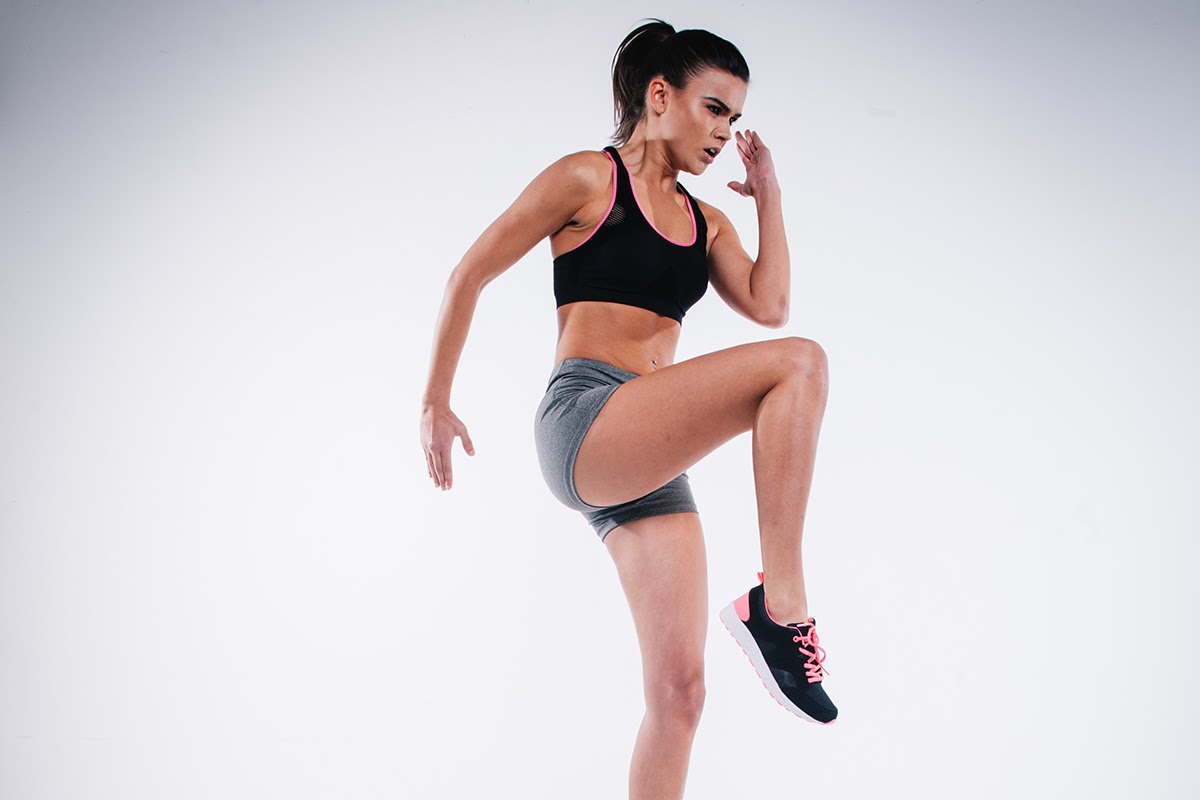Whether you played soccer, ran track and field, or tried out for the football team, chances are you’ve heard of plyometrics.
Combining strength training, cardio, and lots of jumping, plyometrics are body weight exercises that train your muscles to be quick and explosive.
Plyometric exercises include a range of bursting movements that vary in intensity. From HIIT workouts to sports conditioning and other training programs, plyometrics usually form the bulk of a warm-up.
For example, plyometrics include high knees, glute kicks, bounds, and other movements you probably know. Plyometrics can also be high-intensity workouts that are extremely challenging.
Fortunately, if you’re new to plyometric training, you can modify these advanced movements to suit your level of fitness.
Below, you’ll learn some plyometric exercises, and how to progress or modify the movement according to your ability and needs.
8 Plyometric Exercises to Work Into Your Fitness Routine

Plyometrics, like many exercises, are as demanding as you make them. If you’re up for the challenge, try these rigorous, explosive movements in your next workout. Modify as needed to match your fitness level.
1. Plyo Push-Ups
Begin in a plank position, with your hands flat on the floor, slightly wider than your shoulders. Do a regular push-up by lowering yourself to the floor, then explode upward on the way back up. Your hands should come off the floor. You could also try to clap your hands together at the top of the push-up.
For an added challenge, you can progress your plyo push-up to a single-arm plyo push-up by using a medicine ball.
Place one hand on a medicine ball (or bosu ball) and the other on the floor, perform a push-up, then explode upwards and to the side. You want to land so that your opposite hand is positioned on top of the medicine ball, with the other on the floor beside it.
2. Box Jumps
If you’re doing box jumps for the first time, start with a box at a modest height — preferably one at knee height or lower.
Begin standing, crouching slightly before extending your arms and exploding up and onto the box. Land quietly on the box (your goal should be to land softly, thereby reducing your risk of injury) in a squat position.
If the thought of jumping onto a box intimidates you (or if your shins had a run-in with a box that you don’t care to repeat), try a modified movement.
First, you could perform a tuck jump, ideally while facing a mirror, so you can clearly see your movements and how high you’re able to jump.
Otherwise, start with squat jumps, then move to tuck jumps, then finally progress your jump training to land on a box.
3. Burpees
Burpees are a true full-body exercise, working both your upper and lower body. First, start in a standing position, with your feet shoulder-width apart.
Begin to crouch toward the floor, placing your palms firmly on the floor in front of you. Kick your feet backward, so you are positioned in a tall plank, then lower into a push-up. When you return to the top of your push-up, kick your feet in, then explode into a vertical jump.
If you want to modify the upper body portion of this movement, skip the push-up entirely, going directly from a plank position to a vertical jump. You could also perform a modified push-up on your knees at the bottom of the burpee.
4. Depth Jumps
Stand on a box that is roughly the same height as your knees. Start by standing toward the edge of the box, with your toes near the edge. Step off the box, landing softly in a standing squat position. Then, with incredible quickness, explode into a vertical jump.
This plyometric movement is meant to improve your glute strength, speed, and vertical jump height[*]. If you want an added challenge, transform it into a single-leg exercise, jumping up on your left leg or right leg.
5. Bounding
Bounding is a fairly straightforward movement. Begin by jogging, then accelerate to push off your left foot with maximum force.
At your highest point, your right knee should be at a 90° angle, with your right thigh parallel to the floor. When you come back to the floor, switch legs, and continue “bounding” across a given distance.
The goal of bounding is to cover as much ground as possible. Therefore, the only way to progress the movement is by increasing speed or the distance you cover per stride. To modify the movement, take the jump out of it, doing simple walking lunges instead.
6. Broad Jumps
To perform a broad jump, stand with your feet shoulder-width apart. Come into a slight squat with your knees bent as you bring your arms behind your torso.
Using as much explosive power as you can muster, swing your arms forward as you propel your entire body forward. Land softly, in a slight squat position.
To progress a broad jump, add a bit more cardio to the movement. Each time you land, add a burpee or a jump squat, before doing an additional broad jump.
7. Skaters
This plyometric exercise works your glutes, obliques, and hamstrings. Start by standing on your right foot, bringing your left foot behind you, so you land in a curtsey lunge.
Now, propel yourself upward, switching your legs, so your body weight is on your left foot, and your right leg extends behind you in a curtsey. Continue to add speed to the movement, hopping from one leg to the other.
To progress this movement, you can really test your balance. When you land, attempt to keep your back foot hovering above the floor. To stay stable, fire up your glutes and abdominal muscles, which will prevent you from toppling over.
8. Donkey Kicks
This movement tests your explosiveness while forcing you to keep your core engaged.
Start in a crouching position, with your palms pressed into the floor, directly underneath your shoulders.
Slowly push into your hands, while bending your knees and kicking your heels up and toward your glutes. (As the name suggests, you should look like a kicking donkey.)
If a donkey kick is too much for you, try a plank jack instead. Like donkey kicks, plank jacks force you to keep your abs pulled in tightly, while garnering explosiveness from your quads and glutes.
To perform a plank jack, press your forearms into the floor in a low plank position. Then, jump your legs out, so your feet land wider than shoulder-width apart (almost like you’re doing jumping jacks on the floor).
Land, then jump your legs back into your starting position.
Can Plyometric Training Support Your Keto Diet Goals?
If you’re wondering if plyometric training can support your goals on the keto diet, the answer is yes.
Due to the robust nature of the movements that combine cardio, strength training, and explosiveness into every move, plyometrics have been known to improve body composition and reduce body fat[*].
If weight loss or improved BMI is a goal on keto, plyometric training can help you get there.
Like high-intensity interval training (HIIT) and Olympic lifting, plyometrics requires short bursts of energy. To handle these movements, you may need to eat small amounts of carbs prior to your workouts or practice a cyclical keto diet approach.
Plyometrics Are Explosive Movements Working Your Entire Body

Plyometrics are full-body exercises often seen in dynamic workouts, sports conditioning, and HIIT workouts. Plyometrics vary in intensity, from a warm-up consisting of high knees and glute kicks to an intense workout circuit encompassing burpees, box jumps, and clapping push-ups.
Plyometrics require strength, cardio conditioning, and lots of jumping. It’s important to land softly (when jumping), practice proper form, and modify exercises when necessary.
If you follow a keto diet, you may want to eat a moderate amount of carbohydrates before a strenuous plyometric circuit. If plyometrics are a regular part of your fitness routine, you may want to consider switching to a cyclical keto diet.
For more ideas on how to incorporate a consistent exercise routine into your low-carb lifestyle, consult the Perfect Keto exercise plan.